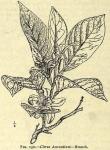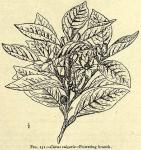278.-281. The Orange Products.

 SOURCE.—Universally cultivated in India and widely in tropical regions. The sweet orange was introduced from China by the Portuguese. It has been much improved by cultivation. There are now some fifty varieties in different parts of the globe, these taking the name of the places where cultivated, the sweetest coming from Havana, Florida, and California. Bitter oranges were introduced into Europe from India by the Arabians and were used medicinally from very early times, the bitter fruit being usually termed the Seville or Bigarade orange.
SOURCE.—Universally cultivated in India and widely in tropical regions. The sweet orange was introduced from China by the Portuguese. It has been much improved by cultivation. There are now some fifty varieties in different parts of the globe, these taking the name of the places where cultivated, the sweetest coming from Havana, Florida, and California. Bitter oranges were introduced into Europe from India by the Arabians and were used medicinally from very early times, the bitter fruit being usually termed the Seville or Bigarade orange.
278. AURANTII AMARI CORTEX.—THE RIND. BITTER ORANGE PEEL, the dried rind of the unripe fruit of Citrus vulgaris Risso. Ash, not to exceed 7 per cent.
AURANTII DULCIS CORTEX.—SWEET ORANGE PEEL, the undried outer rind of the ripe fruit of Citrus Aurantium Linné. The orange tree is cultivated in the south of Europe, in the Azores, and in the United States-Southern States and California. It is said to be one of great longevity; thus, a tree in Versailles, known as the "Grand Bourbon," planted in 1421, is still in existence (Mueller).
DESCRIPTION OF DRUG.—Bitter: In narrow, thin bands or in quarters, epidermis brownish-yellow color, outer layer with numerous oil reservoirs, inner layer spongy, light yellowish-brown; odor fragrant; taste aromatic, bitter. The Curacao orange peel is obtained from a variety of the orange cultivated in the island of Curacao. Sweet: Outer surface orange-yellow with numerous oil reservoirs, odor highly fragrant, taste pungently aromatic.
Powder.—Microscopical elements of: See Part iv, Chap. I, B.
CONSTITUENTS.—Volatile oil (contained in vesicles of the epidermis), hesperidin, ash, and a white principle which turns black with ferric salts.
ACTION AND USES.—Tonic, carminative, and stomachic; a valuable addition to preparations of the bitter tonics like gentian. Dose: 15 to 30 gr. (1 to 2 Gm.).
OFFICIAL PREPARATIONS.
- Bitter Orange Peel.
- Fluidextractum Aurantii Amari, Dose: 15 to 60 <minim> (1 to 4 mils).
- Tinctura Aurantii Amari (20 per cent.), 1 to 2 fl. dr. (4 to 8 mils).
- Tinctura Cinchonae Composita (8 per cent.), to 2 fl. dr. (8 mils)
- Tinctura Gentianae Composita (4 per cent.), to 1 fl. dr. (4 mils)
- Sweet Orange Peel.
- Syrupus Aurantii (5 per cent. of Tinct.), ¼ to 1 fl. oz (8 to 30 mils).
- Tinctura Aurantii Dulcis (50 per cent.), Flavoring.
279. Oleum Aurantii. - The Oil.
279. OLEUM AURANTII—THE OIL. Obtained from the fresh peel of either the bitter or sweet orange. A pale yellow liquid, having a characteristic aromatic odor. Optical rotation should not be more than 95° to the right in a 100 mm. tube, and at a temperature of about 25° C. (77° F.). It contains some hesperidin, and an aldehyde geranial.
Oil of Petit-grain is obtained from the small, fragrant, immature oranges (berries about the size of a cherry). Recently, however, the leaves and shoots have been used for this purpose.
Manufacture.—The oils of the fruit of the Aurantieae are manufactured by subjecting the outer rind to expression, distillation, or, preferably, to the écuelle process. This instrument (the écuelle) is described in most works on pharmacy.
OFFICIAL PREPARATIONS.
- Spiritus Aurantii Compositus (contains 25 per cent. oil and the oils of lemon, coriander, and anise).
- Elixir Aromaticum (1.2 per cent.).
280. AURANTII FOLIA.—THE LEAF. From Cit'rus vulgar'is Risso. Oval, from 50 to 100 Mm. (2 to 4 in.) long, on a broadly-winged petiole, pellucidunctate; odor aromatic; taste bitter. It is the principal source of essence de petit-grain, used to adulterate Oleum Neroli. Stimulant and tonic.
281. AURANTII FLORES.—THE FLOWER. ORANGE FLOWERS. The flowers Cit'rus vulgar'is and C. Aurantium, collected before they are expanded, solely for the volatile oil, which is then most fragrant. Generally used while fresh, in which state they may be preserved for some time by mixing with half their weight of common salt. They are about 12 mm, (½ in.) long, with small, cup-shaped calyx and white, rather fleshy petals. Occasionally used as a stimulant and antispasmodic, but principally for preparing orange-flower water and the volatile oil.
281 a. OLEUM AURANTII FLORUM, U.S. VI—OLEUM NEROLI. A thin, yellowish, or brownish-yellow volatile oil, very fragrant. Used as a flavor and as a perfume. Neroli is the predominant odor in Farina Cologne.

